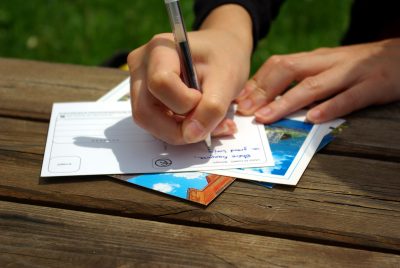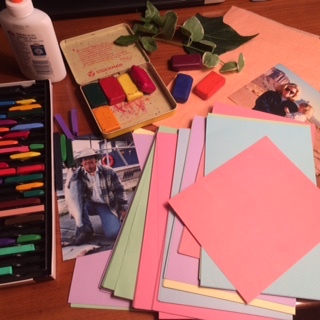 Want to connect with your grandmother or grandfather but can’t go the miles to see them and don’t know what to say over the phone?
Want to connect with your grandmother or grandfather but can’t go the miles to see them and don’t know what to say over the phone?
Stop feeling guilty and start writing! Here are some quick and easy ideas and tips on how to connect and what to say!
Use the US mail, don’t rely on text or email. Send your love and hugs by way of a meaningful postcard, notecard, or short letter. Include a photo from time to time. Postcards and notes can be enjoyed over and over again and will bring new smiles each time. Plus, your card and photo can be shown with pride to friends, care-partnering staff, and other family members. Concerned your grandparent can’t see or read your note? They will enjoy holding it close and looking at it and someone else will read it aloud to them.
Don’t overthink what you write! Write a few words to express feelings of love and gratitude. The feelings of love and joy that you create through your cards will flush through an elder’s whole being and stay with them long after your note is read.
Getting started:
- Buy an assortment of postcards whenever you travel or buy a box of assorted note cards. When buying note cards, get ones that speak to your grandparent’s interests and preferences. Such as ones with photos or sketches of flowers, or birds, scenery, cats or dogs, or old Americana.
- Address and stamp each postcard or envelop. Now your notes are halfway complete!
- Write multiple notes at one time and mail them a week or more apart.
- To accommodate diminished vision, use large and legible lettering.
- Get in the habit of sending one of the cards on a regular basis. Whatever works for your schedule whether it is monthly or weekly or less often. But, do it! You will be glad you did!
- When on a short or long trip, send a postcard. Share your adventures. It does not matter that you will be home before the postcard arrives in their mail. Remember, it is your thoughtfulness that counts and the smile that gets delivered.
Thoughts on what to say:
- Express your love, give compliments, and share happy times, upbeat memories and emotions. This is particularly important if you are writing to a loved one with dementia. As dementia progresses, an individual is most able to connect through words that trigger emotions and feelings.
- Share your adventures through travel postcards! Postcards are great for letting an elder know that you are thinking of them. Remind them of how much you enjoyed going on trips with them when you were little or hearing about their trips to the beach or to the mountains. Thank them for inspiring your love of traveling. Bring your words back to thoughts of your grandparent; remind them how wonderful you think they are, and how much you love them.
- For your grandparent who loved to BBQ, bake, or cook amazing Sunday dinners, remind them of your favorite dishes or desserts that only they could prepare. If writing to your grandmother, let her know of your attempts to make it and how it turned out. Tell her it was almost as tasty and pretty as hers and that it was a big hit with your friends. Thank her for teaching you how to make it and sharing her recipes. Tell her how you happily bragged to your friends that it was your grandmother’s recipe! Give her compliments and you are sure to raise a smile. Let her know if you burned it but will try again. That too will bring a smile.
- For a grandparent who was a gardener, get cards with beautiful plants and flowers on the front and remind them how much you enjoyed their fresh flowers, the roses, the iris, or potted geraniums. Let your grandparent know that you can actually still conjure up the scent of their beautiful yellow roses. Add a sprinkle of floral essential oil or perfume to your card.
- For the outdoorsman, send postcards of mountains, trails, fishing, and big-sky country.
- To the grandparent who could repair anything, share a story of something you repaired!
- If you’re a student, update your grandparent on your studies. They will be proud of your accomplishments. Share your favorite subject, especially, if that subject is important to your grandparent.
Whatever you write, focus on helping your grandparent enjoy the moment! That is the most meaningful and loving way to stay connected from afar.
The feel-good moments you create will be enjoyed repeatedly – each time they pull your card from their pocket, desk, or bag, they will have another opportunity to enjoy it and smile.
Your cards and words will help your grandparent stay engaged in your life, give their life added meaning, and both of you will benefit from the loving feelings expressed.
For more good ideas on how to stay connected with a loved one, go to www.360eldersolutions.com or contact, Sue S. Wilson, LMSW at sue@360eldersolutions.com to make an appointment for a free initial 30-minute consultation. Sue is a Certified Trainer for AGE-u-cate® Training Institute.
 Our guest blogger is AGE-u-cate Master Trainer, Sue Wilson, LMSW, CADDCT, CDP – 360 Elder Solutions (
Our guest blogger is AGE-u-cate Master Trainer, Sue Wilson, LMSW, CADDCT, CDP – 360 Elder Solutions (